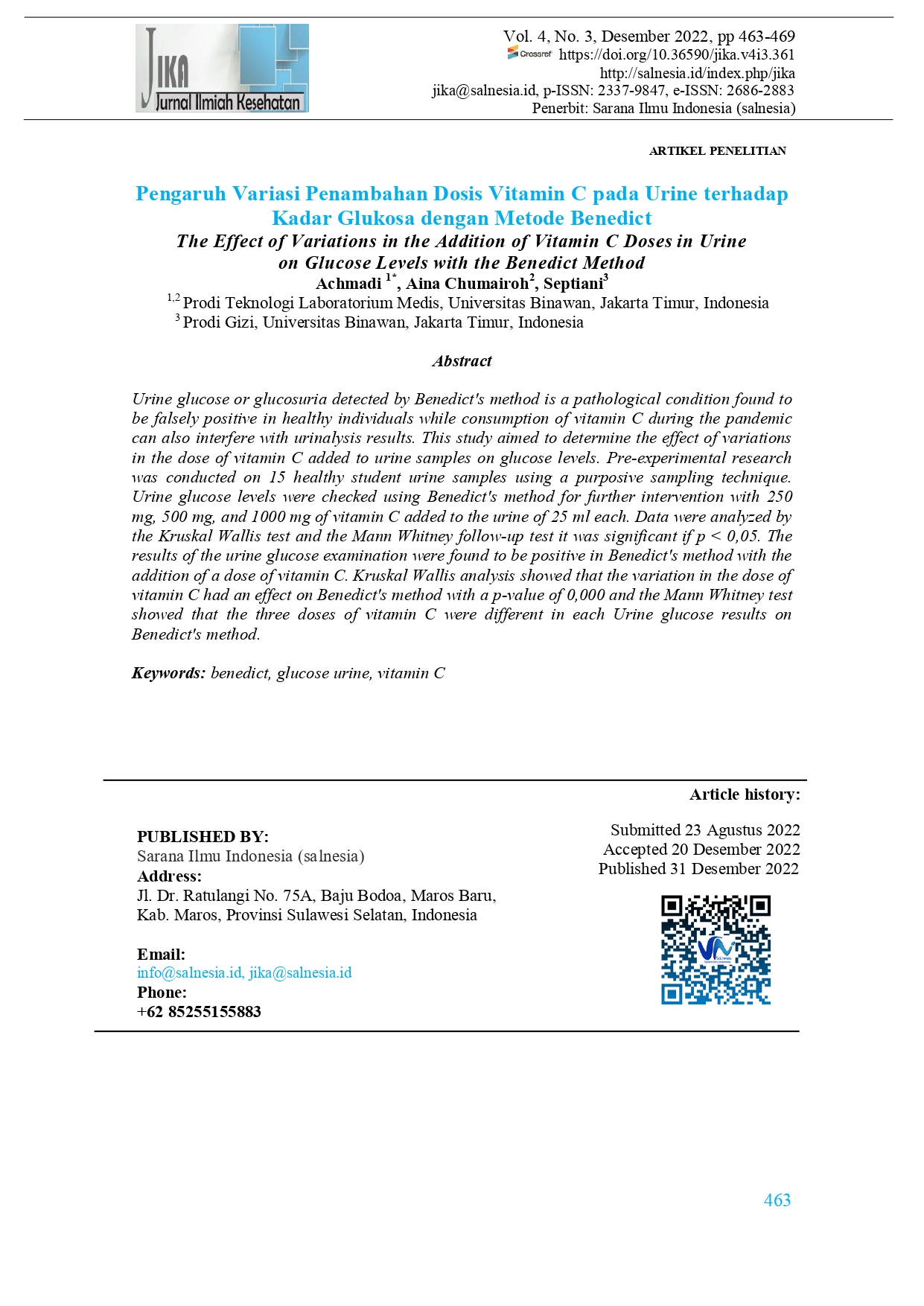The Effect of Variations in the Addition of Vitamin C Doses in Urine on Glucose Levels with the Benedict Method
DOI:
https://doi.org/10.36590/jika.v4i3.361Keywords:
benedict, glucose urine, vitamin CAbstract
Urine glucose or glucosuria detected by Benedict's method is a pathological condition found to be falsely positive in healthy individuals while consumption of vitamin C during the pandemic can also interfere with urinalysis results. This study aimed to determine the effect of variations in the dose of vitamin C added to urine samples on glucose levels. Pre-experimental research was conducted on 15 healthy student urine samples using a purposive sampling technique. Urine glucose levels were checked using Benedict's method for further intervention with 250 mg, 500 mg, and 1000 mg of vitamin C added to the urine of 25 ml each. Data were analyzed by the Kruskal Wallis test and the Mann Whitney follow-up test it was significant if p < 0,05. The results of the urine glucose examination were found to be positive in Benedict's method with the addition of a dose of vitamin C. Kruskal Wallis analysis showed that the variation in the dose of vitamin C had an effect on Benedict's method with a p-value of 0,000 and the Mann Whitney test showed that the three doses of vitamin C were different in each Urine glucose results on Benedict's method.
Downloads
References
AKG [Angka Kecukupan Gizi]. 2019. Angka Kecukupan Gizi, Peraturan Menteri Kesehatan Republik Indonesia. Jakarta: Kemenkes
Alfin Septia Putri A, Kalsum U, Fatmawati F. 2019. Pengaruh Suplementasi Besi (Fe) Dosis Tinggi Terhadap Kondisi Sel Beta Pankreas pada Tikus Putih (Rattus Norvegicus) Strain Wistar Bunting. Journal Of Issues In Midwifery, 3(1): 20–25. https://doi.org/10.21776/ub.joim.2019.003.01.3.
Dahal Prashant. 2022. Benedict’s Test-Principle, Procedure, Steps, Results, Uses. .
Dosed?l M, Jirkovský E, Macáková K, Kr?mová LK, Javorská L, Pourová J, Mercolini L, Remião F, Nováková L, Mlad?nka P. 2021. Vitamin c—sources, physiological role, kinetics, deficiency, use, toxicity, and determination. Nutrients, 13(2): 1–36. https://doi.org/10.3390/nu13020615.
Evan A, Emile S, Ford M. 2020. Impact of COVID-19 on Vitamins, Minerals and Supplements. L.E.K. Consulting. Executive Insights.
Gandasoebrata R. 2013. Penuntun Laboratorium Klinik. cet. 15. Jakarta: Dian Rakyat. hal, 11–34.
Kemenkes [Kementerian Kesehatan RI]. 2018. Hasil Riset Kesehatan Dasar (Riskesdas). Badan Penelitian dan Pengembangan Kesehatan.
Ko DH, Jeong TD, Kim S, Chung HJ, Lee W, Chun S, Min WK. 2015. Influence of vitamin C on urine dipstick test results. Annals of Clinical and Laboratory Science, 45(4): 391–395.
Kusumawati K, Saragi S, Putrianti L2022. Keputusan pembelian produk vitamin c di masa pandemi covid-19. Fair Value: Jurnal Ilmiah Akuntansi dan Keuangan, 4(7): 2859–2865.
Liman MNP JI. 2022. Physiology, Glycosuria. StatPearls.
Mundt AL; SK. 2016. Graff’s Textbook of Urinalysis and Body Fluids, 3nd Edition. Medicine & Science in Sports & Exercise.
Neurosensum. 2021. Indonesia Consumer Trends.
Nurjannah L, Suryani S, Achmadi SS, Azhari A. 2017. Produksi Asam Laktat oleh Lactobacillus delbrueckii subsp. bulgaricus dengan Sumber Karbon Tetes Tebu. Jurnal Teknologi dan Industri Pertanian Indonesia, 9(1): 1–9. https://doi.org/10.17969/jtipi.v9i1.5903.
Pacier C, Martirosyan DM. 2015. Vitamin C: Optimal dosages, supplementation and use in disease prevention. Functional Foods in Health and Disease, 5(3): 89–107. https://doi.org/10.31989/ffhd.v5i3.174.
Rantung O, Korua AI, Datau H. 2021. Perbandingan Ekstraksi Vitamin C dari 10 Jenis Buah-Buahan Menggunakan Sonikasi Dan Homogenisasi. Indonesian Journal of Laboratory, 4(3): 124–133. https://doi.org/10.22146/ijl.v4i3.69983.
Shah AH. 2012. the Effect of Ascorbic Acid on Glucose Urine Assay By Copper Sulphate Reducing System and Hexokinase Method. Canadian Journal of Applied Sciences, 2(2): 184. https://doi.org/10.21065/19257430.2.184.
Sulfia F, Fikri Z, Fauzi I. 2018. Pengaruh Kadar Glukosa Urine Metode Benedict, Fehling Dan Stick Setelah Ditambahkan Vitamin C Dosis Tinggi/ 1000 Mg. Jurnal Analis Medika Biosains (JAMBS), 5(2): 96–100.
Wibawa JC, Wati LH, Arifin MZ. 2020. Mekanisme Vitamin C Menurunkan Stres Oksidatif Setelah Aktivitas Fisik. JOSSAE?: Journal of Sport Science and Education, 5(1): 57. https://doi.org/10.26740/jossae.v5n1.p57-63.
Yanuar Dini C, Sabila M, Yusuf Habibie I, Ari Nugroho F. 2017. Asupan Vitamin C dan E Tidak Mempengaruhi Kadar Gula Darah Puasa Pasien DM Tipe 2. Indonesian Journal of Human Nutrition, 4(2): 65–78. https://doi.org/10.21776/ub.ijhn.2017.004.02.1.
Yussif NM. 2019. Vitamin C. In: LeBlanc JG (ed) Vitamin C. IntechOpen: Rijeka.

Downloads
Published
How to Cite
Issue
Section
License
Copyright (c) 2022 Achmadi, Aina Chumairoh, Septiani

This work is licensed under a Creative Commons Attribution 4.0 International License.








